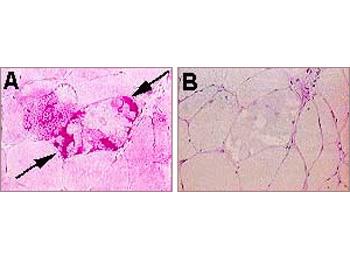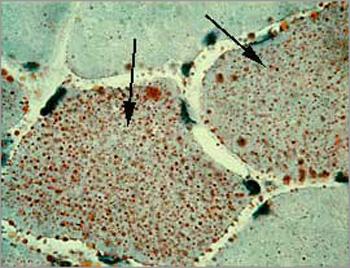
Metabolic muscle disorders are related to defects in the enzymes that regulate carbohydrates, lipids, or other metabolic pathways in the muscle fibers. The most common disorders are related to glycogen storage problems. Patients with these disorders complain of inexplicable pain or fatigue after short duration (10-15 minutes) exercises. Cramps are a prominent complaint. These disorders may go undiagnosed for many years as patients attribute their symptoms to being "out of shape." The episodic occurrence of the complaints does not necessarily signify a benign outcome. As the disease progresses, the patient may develop a progressively worsening permanent muscle weakness.
Diagnosis

The diagnosis of glycogen-storage metabolic muscle diseases can be quite challenging. They are first suspected when a history of intermittent exercise-induced muscle cramps and myalgias is given. Not all muscle cramps, however, are related to metabolic muscle diseases and can be due to benign etiologies. When benign entities are ruled out and metabolic myopathy is suspected, the first diagnostic step is to perform an electromyogram. This is necessary to exclude other conditions. A normal EMG, however, does not rule out a metabolic muscle disease. The next step would be to perform an ischemic exercise test. An abnormal ischemic exercise test usually indicates an abnormality in the glycogen metabolism and would prompt a muscle biopsy which usually reveals vacuoles containing PAS-positive material. Specific enzyme deficiencies (myophosphorylase, phosphofructokinase, or others) may be demonstrated by appropriate histochemical reactions.
The muscle biopsy also helps to confirm some abnormalities of the lipid metabolism. In those cases the muscle biopsy is essentially normal except for the presence of abnormal lipid deposits in the majority of the fibers with oil-red-O stain. In both glycogen and lipid storage myopathies, quantitative measurement of the deficient enzyme will confirm the diagnosis.
There is no specific treatment for many of the metabolic muscle disorders. Once a particular defect is identified, attempts are made to instruct the patient to avoid precipitating factors. In some disorders, such as carnitine deficiency, a lipid myopathy, attempts have been made with variable success to treat the condition with oral carnitine.








